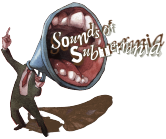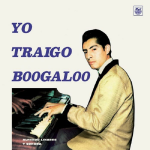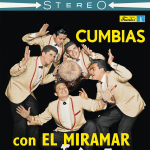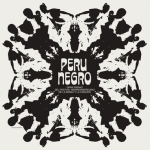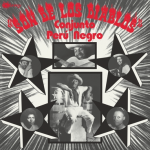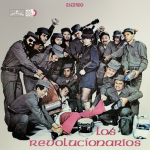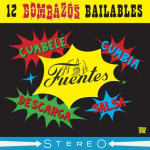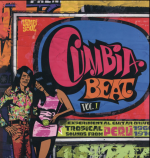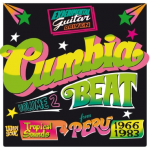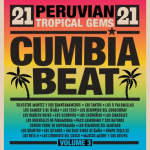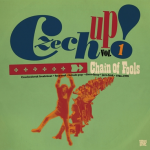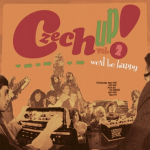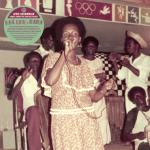Labels
Vampi Soul
- 01. Boogaloo En Ambiente
02. La Sonora Llego
03. Como Yo No Hay Dos
04. Peruvian Guaguanco
05. Congalanque
06. Yo Traigo Boogaloo
07. Probandolo Se Sabe
08. Linares Blue's
09. Sabor Tropical
10. Tutu TataALFREDO LINARES Y SU SONORA
Yo Traigo Boogaloo
- Format
- LP
- Release-Datum
- 26.09.2020
- 01. Cumbia Loca
02. Mensaje Guajiro
03. Gaita Turca
04. Mosaico: Catalina / Amorcito Lindo / Chela
05. El Morrocoy
06. La Pompita
07. Cumbia Del Sol
08. Moler La Caña
09. Cumbia De Estrellas
10. Lelogua
11. Noche Y Cumbia
12. Mosaico: La Silenciosa / La Pestañita / Sufre NegraCONJUNTO MIRAMAR
Cumbias con El Miramar
[engl] First ever reissue of "Cumbias con El Miramar", a very hard-to-find album released by Discos Fuentes in 1965. Full of excellent cumbias and gaitas for dancing, the record actually is a lot more diverse than the title leads one to believe, as there are lots of other hot rhythms and arrangements on it, taken from Cuban genres like guajira, guaracha, guaguancó, charanga and son montuno. Presented in facsimile artwork and pressed on 180g vinyl. Part of Vampisoul's reissue series of classic Fuentes LPs.- Format
- LP
- Release-Datum
- 02.08.2019
- EAN
- EAN 8435008863432
- 01. Pobre Negrita
02. Los machetas
03. Toro mata
04. Navidad negra y zapateo criollo
05. Canción para Ekué
06. Landó
07. El payande
08. Negrito de dónde vienes
09. Ollita nomáPERU NEGRO
s/t
[engl] Afro-Peruvian music, also known as “música criolla”, finds its roots in West African music, Spanish and European genres and native musical traditions from Peru. Flamenco-influenced sounds sit next to African tribal elements and a simple yet effective percussion instrument called cajón.After a long struggle to preserve música criolla through oral tradition over generations, actually resulting in much of the original music being lost, a renewed interest in those rhythms and melodies arose in the 1950s. Some years later the legendary Peruvian singer Chabuca Granda provided help to promote Perú Negro, a dance company that also incorporated percussion combined with música criolla. Ronaldo Campos, “Lalo” Izquierdo, Víctor Padilla, Rodolfo Arteaga and Caitro Soto, among others, played a key role in the foundation and early days of the company. Their shows celebrated and recreated black culture in Peru and they quickly became regulars at Lima’s theatres.In 1969 they won the main award at the Festival Hispanoamericano de la Danza y la Canción in Argentina. The repertoire performed at the festival was later included in this album, originally released in 1973 in Peru and Spain only. The lyrics and music of these songs reflect the country’s multicultural diversity, blending elements from the African tradition and echoes of Spanish-influenced melodies around stories of slavery days, rural labour and folklore.Although lesser known than music from other nearby countries, Peru Negro’s recordings are reminiscent of Afro-Colombian or Afro-Cuban rhythms. If you have an interest in Cuban son or Colombian bambuco, this record will be an essential addition to your collection and the perfect introduction to the fascinating música criolla.- Format
- LP
- Release-Datum
- 12.07.2019
- EAN
- EAN 8435008863401
- 01. Arriba Perú Negro
02. Mi compadre Nicolás
03. Mama Ñangue
04. Kike Iturrizaga
05. Torito pinto
06. Son de los diablos
07. Congorito
08. Alcatraz quema tú
09. Negrito d ela Huayrona
10. Juan De MataPERU NEGRO
Son De Los Diablos
[engl] Afro-Peruvian music, also known as “música criolla”, finds its roots in West African music, Spanish and European genres and native musical traditions from Peru. Flamenco-influenced sounds sit next to African tribal elements and a simple yet effective percussion instrument called cajón.After a long struggle to preserve música criolla through oral tradition over generations, actually resulting in much of the original music being lost, a renewed interest in those rhythms and melodies arose in the 1950s. Some years later the legendary Peruvian singer Chabuca Granda provided help to promote Perú Negro, a dance company that also incorporated percussion combined with música criolla. Ronaldo Campos, “Lalo” Izquierdo, Víctor Padilla, Rodolfo Arteaga and Caitro Soto, among others, played a key role in the foundation and early days of the company. Their shows celebrated and recreated black culture in Peru and they quickly became regulars at Lima’s theatres.In 1969 they won the main award at the Festival Hispanoamericano de la Danza y la Canción in Argentina. The repertoire performed at the festival was later included in this album, originally released in 1973 in Peru and Spain only. The lyrics and music of these songs reflect the country’s multicultural diversity, blending elements from the African tradition and echoes of Spanish-influenced melodies around stories of slavery days, rural labour and folklore.Although lesser known than music from other nearby countries, Peru Negro’s recordings are reminiscent of Afro-Colombian or Afro-Cuban rhythms. If you have an interest in Cuban son or Colombian bambuco, this record will be an essential addition to your collection and the perfect introduction to the fascinating música criolla.- Format
- LP
- Release-Datum
- 03.04.2020
- EAN
- EAN 8435008863630
- A1 Perdoname Leandro
A2 Esa Mulata
A3 Caribe
A4 Los Carasucias
B1 Salsa De Monte Adentro
B2 La Mezcla
B3 Toro Barcino
B4 Josefina
B5 Bajo El Palo ‘E MangoREVOLUCIONARIOS, LOS
Last Band Standing
[engl] A revolutionary album with a sound unlike that of any other tropical record before or after which could only have come from the Caribbean region of Colombia and the fertile mind of the band's leader, Alfredo Gutiérrez. What makes this record unique and a highly sought-after collector's piece are the innovative arrangements that mix a sax section with electric organ, piano and accordion, and its killer version of Javier Vázquez's hard salsa tune `Esa mulata'. The rest of the album has more hot salsa, boogaloo and descarga, plus local flavors like paseo and porro and even a Dominican merengue. Presented in facsimile artwork and pressed on 180g vinyl. Part of a new Vampisoul reissue series of classic LPs from Colombia's Codiscos and its group of labels such as Zeida and Costeño.- Format
- LP
- Release-Datum
- 24.05.2019
- EAN
- EAN 8435008863364
- 01. Lito Barrientos y su Orquesta - Cumbia en Do menor
02. Lisandro Meza y su Combo Gigante - Arrebatá
03. Combo Los Yogas - Coco May May
04. Peregoyo y su Combo Vacaná - La pluma
05. Adolfo Echeverría y su Orquesta - Sabroso bacalao
06. Pedro Laza y sus Pelayeros - Lindo Magdalena
07. Fruko y sus Tesos - El vidriero
08. Los Supremos - Atiza y ataja
09. Conjunto Miramar - Cumbia loca
10. Michi Sarmiento y su Combo Bravo - Manué
11. Tita Duval y el Nuevo Ritmo de Bobby Rey - Safari Safari
12. Sexteto Miramar - Mambo flamencoV/A
12 BOMBAZOS BAILABLES
[engl] Discos Fuentes, the renowned Colombian record label, home to some of the best tropical recordings ever made, turns 85 this year, becoming the longest running independent music company in the World! Their vast catalogue comprises many different tropical genres, from cumbia or boogaloo to hard salsa, cumbelé or bomba, becoming an essential reference point for any Latin Music aficionado.Vampisoul started the on-going Discos Fuentes reissue series in early 2017, making some of the most solid and highly sought-after titles available again, presented in facsimile artwork and pressed on 180g vinyl. Many of our reissues have become instant collector items as the demand was big due to the extreme difficulties of getting hold of original clean copies and the very high prices paid for them.We have now put together a collection of 12 top dancefloor oriented songs, as a taste of and introduction to our reissue series and as a celebration to the 85 anniversary of Discos Fuentes. It includes tracks by the likes of Fruko y sus Tesos, Michi Sarmiento y su Combo Bravo and Lito Barrientos y su Orquesta, and also lesser known artists whose legendary recordings have become classic DJ spins in the tropical sounds scene over the years. Every track is a winner!- Format
- LP
- Release-Datum
- 17.01.2020
- EAN
- EAN 8435008863562
V/A
Cumbia Beat Vol.1
[engl] Originally released in 2010. Available again after several years out of print. Cumbia and Chicha ! Experimental Guitar-driven Tropical Sounds from Peru 1966-1978. In 1960s Peru, a thrilling and unstoppable style of music is born: Peruvian cumbia, also known as "chicha". Tropical genres such as merengue, guaracha, rumba and cumbia mix with 60s beat and psychedelic rock, while electric guitars reinterpret folk melodies and traditions from the Andes and the Amazonian jungle, in a musical representation of the exodus from rural areas to Lima and other big cities. First volume of a new series dedicated to documenting this most exciting and popular genre. In mid-50s Peru, mambo was progressively replaced by preferences for other rhythms like merengue, guaguancó, cha cha cha, joropo, guaracha, rumba and cumbia, which timidly begins to sound during these years. In Lima it's the golden age of great orchestras and music ensembles which are capable of playing swing and jazz, but especially the diverse tropical variants inundating the market. The most successful of all, La Sonora de Lucho Macedo, released in 1965 an LP consisting exclusively of cumbia. Around this time, the successful folklore group Los Pacharacos released the album "Los ídolos del pueblo", which included a cumbia number in the middle of the potpourri of huaynos, waltzes and polkas. The marriage between folklore and cumbia had taken place. The groups preserved the fusion of fox trot and mambo rhythms along with huayno and cumbia in the execution of their music. That feeling would be the basis for the success of such unorthodox and unclassifiable songs as 'La chichera' or 'Petipan'. The recording in 1965 of these two songs by Los Demonios del Mantaro on a seminal 45 rpm with the Sono Radio label was the jumping off point for the birth of cumbia andina, also called "chicha" precisely for this song, which is dedicated to a vendor of the well-known Incan liquor. The electric shock of rock guitars enters the world of cumbia in 1968. The cause of such copulation was Enrique Delgado Montes, regarded as the genre's godfather. He did it, as part of his band Los Destellos, on a 45 ('El avispón' / 'La malvada') and an eponymous LP. His songs constitute the most surprising musical fusions and amalgams of the time: whether they merge Cuban music and psychedelia, explore the sounds of Andean or Amazonian music, combine the digitalization of the Creole guitar with huayno melodies or abuse fuzz tones and distortion pedals with enormous strength. The metamorphosis of cumbia turns it into a genre that seems to voraciously cannibalize acoustic traditions and modern technologies. There wasn't an innovation that tropical guitarists didn't add to their sound: delay, fuzz tone, overdrive, wahwah, reverb, modulating effects typical of rock bands are assimilated into a stunning sonic cocktail. In this context, cumbia reached the top of the charts in popularity. Cumbia replaced rock as the urban sound. The groups would slowly develop an ethnic sensibility inspired by native Shipibo motifs and an astonishing and bewitching sound that seemed to drink from all the mysteries, secrets and myths of the jungle.- Format
- DoLP
- Release-Datum
- 07.05.2010
- EAN
- EAN 8435008862114
V/A
Cumbia Beat Vol.2
[engl] Originally released in 2010. Available again after several years out of print. Cumbia and Chicha ! Experimental Guitar-driven Tropical Sounds from Peru 1966-1978. In 1960s Peru, a thrilling and unstoppable style of music is born: Peruvian cumbia, also known as "chicha". Tropical genres such as merengue, guaracha, rumba and cumbia mix with 60s beat and psychedelic rock, while electric guitars reinterpret folk melodies and traditions from the Andes and the Amazonian jungle, in a musical representation of the exodus from rural areas to Lima and other big cities. First volume of a new series dedicated to documenting this most exciting and popular genre. In mid-50s Peru, mambo was progressively replaced by preferences for other rhythms like merengue, guaguancó, cha cha cha, joropo, guaracha, rumba and cumbia, which timidly begins to sound during these years. In Lima it's the golden age of great orchestras and music ensembles which are capable of playing swing and jazz, but especially the diverse tropical variants inundating the market. The most successful of all, La Sonora de Lucho Macedo, released in 1965 an LP consisting exclusively of cumbia. Around this time, the successful folklore group Los Pacharacos released the album "Los ídolos del pueblo", which included a cumbia number in the middle of the potpourri of huaynos, waltzes and polkas. The marriage between folklore and cumbia had taken place. The groups preserved the fusion of fox trot and mambo rhythms along with huayno and cumbia in the execution of their music. That feeling would be the basis for the success of such unorthodox and unclassifiable songs as 'La chichera' or 'Petipan'. The recording in 1965 of these two songs by Los Demonios del Mantaro on a seminal 45 rpm with the Sono Radio label was the jumping off point for the birth of cumbia andina, also called "chicha" precisely for this song, which is dedicated to a vendor of the well-known Incan liquor. The electric shock of rock guitars enters the world of cumbia in 1968. The cause of such copulation was Enrique Delgado Montes, regarded as the genre's godfather. He did it, as part of his band Los Destellos, on a 45 ('El avispón' / 'La malvada') and an eponymous LP. His songs constitute the most surprising musical fusions and amalgams of the time: whether they merge Cuban music and psychedelia, explore the sounds of Andean or Amazonian music, combine the digitalization of the Creole guitar with huayno melodies or abuse fuzz tones and distortion pedals with enormous strength. The metamorphosis of cumbia turns it into a genre that seems to voraciously cannibalize acoustic traditions and modern technologies. There wasn't an innovation that tropical guitarists didn't add to their sound: delay, fuzz tone, overdrive, wahwah, reverb, modulating effects typical of rock bands are assimilated into a stunning sonic cocktail. In this context, cumbia reached the top of the charts in popularity. Cumbia replaced rock as the urban sound. The groups would slowly develop an ethnic sensibility inspired by native Shipibo motifs and an astonishing and bewitching sound that seemed to drink from all the mysteries, secrets and myths of the jungle.- Format
- DoLP
- Release-Datum
- 28.09.2012
- EAN
- EAN 8435008862633
V/A
Cumbia Beat Vol.3
[engl] The third volume of our "Cumbia Beat" series includes again tracks by the some of the most important bands of the golden age of Peruvian cumbia: Los Diablos Rojos, Los Beta 5, Los Girasoles, Los Ecos, Los Demonios del Mantaro, Los Sander's de Ñaña_ Peruvian cumbia brings together tropical music styles from Colombia and Cuba, Western influences such as 60s beat and psychedelic rock, and mixes them with indigenous melodies from the Amazonian jungle and traditional Andean songs. The result is a unique and vibrant style of music which reverberates with life.- Format
- DoLP
- Release-Datum
- 29.03.2019
- EAN
- EAN 8435008863326
- 01. Komety - Chain Of Fools
02. Papel Novák & Vox - Kocicí král Felix
03. Flamingo - Zlom vaz
04. Discobolos - Kyvadlo
05. Golden Kids - Nestuj a pojd (u nás máme mejdan)
06. Helena Blehárová - Závrat
07. Karel Cernoch - Už tu nesmím zustat (Uptight, Everything's Alright)
08. Bezinky - Jedeme dál
09. Petr Spáleny - Lesní víla
10. Flamengo - Poprava blond holky
11. Blue Effect - Blue Taxi
12.Václav Tyfa - Loutna ceská: Domácí vojna mezi telem a duší
13. Atlantis - Nikdy nebudu tvá
14. Eva Pilarová - Léto, léto
15. Viktor Sodoma - Vysoká hra
16. Jazz Cellula - Polobotka
17. Josef Laufer & Their Majesties - Útek z hladomorny
18. Framus Five - Around And Around
19. Jitka Zelenková & The Gondolán Brothers - Já nechci mít
20. George & Beatovens - Lež bláznivého básníka
21. The Bluesmen - Story o velké lásce
22. Karel Gott - I've Never Been So Young
23. Ferdinand Havlík Orchestra - Beat
24. Mahagon - Ve svetle petrolejky
25. Waldemar Matuska - Barbarella (An Angel Is Love)V/A
CZECH UP Vol. 1
[engl] First volume of Vampisoul’s new series “Czech Up!”, which compiles 60s and 70s gems from the vaults of the Supraphon and Panton labels from the former Czechoslovakia. Freakbeat, fuzz-soul, pop, jazz-funk, garage rock, psych… all that and more is contained within these 25 tracks, wonderfully produced and now carefully remastered, many of them never reissued before. Includes detailed liner notes by Lukáš Machata. Welcome to “Czech Up! Vol 1: Chain Of Fools”, the first installment of random gems from the Supraphon vaults. It’s a compilation concept we’ve had in mind ever since we began our collaboration with Supraphon several years ago, but which wasn’t initially possible to accomplish due to – luckily temporary – licensing restrictions. For that reason, at first we focused on retrospective albums by Czech artists such as Marta Kubišová, Emil Viklicky, The Matadors and Olympic. However, in the meantime, just as Supraphon is steadily progressing with revalidating their immense back catalogue, we can now finally move along with them, picking up their cherries as they keep popping up on the notional surface. The Supraphon label was established in the former Czechoslovakia and has continuously been active since the early 1950s. While it has always been highly esteemed by music connoisseurs for its excellent classical music releases, Supraphon’s pop, rock and jazz music catalogue is internationally less known, although it’s in fact even larger, comprising around 60,000 unique tracks. Today it also incorporates the complete back catalogue of Panton, also a Czechoslovak label launched in 1967 that existed independently until the late 1990s. “Czech Up! Vol 1” highlights a collection of tracks that were originally released in Czechoslovakia between 1966 and 1978 on the Supraphon and Panton labels. Several psychedelic freakbeat favourites were chosen by Vampisoul’s Iñigo Munster, whereas the regular associate and expert on Czechoslovak music, Lukáš Machata of the “Funky Czech-in” website at blog.loukash.com, has selected a variety of grooving soul, jazz and pop nuggets. Lukáš Machata – a longtime sound engineer and graphic designer – is also responsible for the carefully processed digital remasters and for the retro-style cover artwork. And so the compilation’s huge range goes from the never reissued fuzz-soul of Komety and the lush downtempo disco by Bezinky, to the Afro-influenced pop hit of Eva Pilarová and the fierce Jazz Cellula funk, over to Gondolán Brothers’ Gypsy beat introducing Jitka Zelenková, to the frantic garage rock with Blue Effect, Flamengo and George & Beatovens, through to schlager music star Karel Gott’s atypical R&B outing and to Mahagon’s hypnotic fusion jazz-funk, up to the arousing ‘Barbarella’ interpretation by the incomparable idol Waldemar Matuška. We’re commemorating well known classics by the Golden Kids supergroup comprising Václav Neckár, Marta Kubišová and Helena Vondrácková, by the accomplished vocal acrobat Karel Cernoch with his Stevie Wonder cover version, or by Michal Prokop’s confidently soulful Framus Five combo. We’ve dug out undeservedly neglected bijoux by the graceful Helena Blehárová with the Gustav Brom Orchestra, the almost avant-gardist Petr & Jan Spáleny? from Apollobeat, the ex-Matadors shouter Viktor Sodoma, the sympathetic Pavel Novák & his Vox group, the trumpet virtuoso Václav Ty?fa with Josef Vobruba’s all-star jazz-rock ensemble Konstelace, the studio group Discobolos, the extravagant Josef Laufer & Their Majesties, by the enigmatic Bluesmen, and by jazzman Karel Ružicka with the Ferdinand Havlík Orchestra. Last but not least, we’re also presenting teaser tracks from our upcoming retrospective albums by the funky Flamingo group featuring Petr Nemec with “lady soul” Marie Rottrová, and by the psychedelic pop band Atlantis fronted by the siblings Hana & Petr Ulrych. We have grooves you can dance to, songs you can chill to, breaks you can rap to, or simply 25 tracks you should listen to. So… czech up, and get down!- Format
- DoLP
- Release-Datum
- 18.03.2016
- EAN
- EAN 8435008863050
- 01. Olympic - Bláznivej kiki
02. Hana Ulrychová - A co má bejt
03. Mahagon - Prameny poznání
04. Framus Five - Hold On, I’m Coming
05. Apollobeat - Nocní Modlitba
06. Beatings - We’d Be Happy
07. Valerie Cizmárová - Byls má bój
08. Gustav Brom Orchestra -Písu krídou zprávu
09. Blue Effect - Snakes
10. Shq - V Obore
11. Metronom - Divný Pán
12. Synkopy 61 - Bytost Podivná
13. Jazz Q - The Wizard
14. Vulkán - It’s Always Ever The Same
15. George & Beatovens - Zahrada za domem
16. Flamengo - Zavrazdil jsem lásku
17. Eva Pilarová - Padni na kolena
18. Flamingo - Tvuj prítel vítr
19. The Soulmen - I Wish I Were
20. Barnodaj - Dzungle
21. Hana Zagorová - Rokle
22. Karel Cernoch - Trznice svetaV/A
CZECH UP Vol. 2
[engl] Welcome to the second Vampisoul set of trouvailles from the Supraphon vaults, a series of compilations that we launched in 2016 under the title “Czech Up!”. It’s a concept that we had in mind ever since we began our collaboration with Supraphon over ten years ago, but that wasn’t initially possible to accomplish due to – luckily temporary – licensing restrictions. In the meantime, just as Supraphon is steadily progressing with revalidating their immense back catalogue, we’re now able to move along with them, picking up their cherries as they keep popping up on the notional surface.The Supraphon label was established in the early 1950s in former Czechoslovakia and has been continuously active ever since. While it’s always been highly esteemed by music connoisseurs for its excellent classical music releases, Supraphon’s pop, rock and jazz music catalogue, although comprising around 60,000 unique tracks, remains for the most part a big unknown to the international audience. Today it also incorporates the complete back catalogue of Panton, another Czechoslovak label launched in 1967 that operated independently until the late 1990s.On “Czech Up! Volume 2”, we’re again presenting an array of astounding songs from the otherwise inglorious decade of political and social gloom in Czechoslovakia, a decade that actually started shortly after the invasion of the Warsaw Pact armies in 1968. Here’s your chance to meet up with some eccentric fools, wry sarcasm, fountains of cognition, lovers approaching, lovers leaving, faunal fables, bizarre beings, wizardly seasons, ordinary oddities, unearthly gardens, morbid dreams, pretense obedience, melancholy windscapes, wishful thinking, exotic jungles and eerie ravines… So whether you’re hanging loose, shaking a leg, sampling some of this’n’that, or just opening your mind and ears widely, here’s 22 more tracks that won’t let you down while you’re czeching up.- Format
- DoLP
- Release-Datum
- 15.06.2018
- EAN
- EAN 8435008863203
- 01. Gertrudis Bonilla y Jimmy Puche -Manuela La Bullanguera
02. Peregoyo y su Combo Vacaná -El Coco de la Vieja
03. Chencho Trompeta y Los Brujos del Folklore - La Logia
04. La Marucha -Caso del Vencedor
05. Julián y su Combo Sabor - Canalete de Charchajo
06. Los Trovadores del Pacífico - La Tunda
07. La Sonora del Pacífico de Cachito Vidal - El Chocoanito
08. La Contundencia - Patio No
09. Alfonso Córdoba “El Brujo” y La Banda de Alexis - Caderona
10. La Sonora del Pacífico de Cachito Vidal - La Viuda
11. Gertrudis Bonilla - La Canoa Ranchara
12. Peregoyo y su Combo Vacaná - Sácale Brillo Teresa
13. Julián y su Combo - Petra
14. Gertrudis Bonilla - Soy el Currulao
15. Conjunto Folklórico Los de la Bahía de la Cruz (canta Markitos Micolta) - Cangrejo Pendejo
16. La Contundencia - Kilele
17. Gertrudis Bonilla - Parranda a lo Trasnochao
18. Peregoyo y su Combo Vacaná - Boga, Boga Canoero
19. Buscajá - Llorando Por Amor
20. Bambazulú - Un Gualí
21. La Sonora del Pacífico de Cachito Vidal - Pascual RoviraV/A
GUASÁ, CUNUNO Y MARIMBA
[engl] The Colombian Pacific coast has always been one of the most forgotten regions of Colombia: ninety percent of the population are of African descent and ten percent indigenous peoples and mestizos. It’s a region of dense tropical rain forest and the second rainiest place on earth. It borders Panama to the north and Ecuador to the south. Most of the population live around the urban centres like Buenaventura, Quibdó, Guapi, Timbiquí and Tumaco. Colonised late, after several failed attempts by the Spanish who were thwarted by the impenetrable jungle and climate of the territory.Two or three centuries of slavery filled the Pacific coast with the most prestigious African dynasties. These men and women brought their musical instruments with them and all their baggage of beautiful melodies and ancestral harmonies which would find new life in the New World.In the department of Chocó in the north Pacific, Afro-descendants reinterpreted the military drums brought in by the colonisers, creating the chirimía style, combining side drums with the sounds of the clarinet and euphonium, a jazz fanfare from the Colombian Pacific. The Pacific coast is home to a wealth of musical styles: apart from the currulao and chirimía, there’s a host of other genres including tamborito, abozao, aguabajo, jota, bunde, torbellino, juga, bambuco, alabaos, chigualos and gualíes and many other we know about or are yet to discover.The black population integrated as soon as they arrived with the native Indian cosmogony, enriching their cultural baggage with shamanic traditions and sciences of the local community. Meanwhile, in the city of Buenaventura, the urban centre of the Pacific and the biggest port in Colombia, orchestras and bands flourished. Cuban hit records reached these shores from Puerto Rico and from across the Spanish-speaking Caribbean.The earliest recordings date back to the beginning of the sixties, from the cities of Cali and Buenaventura, but for music from the Pacific there was a long and winding road to go down before it emerged from anonymity in a country dominated by cumbia and Caribbean beats, which ignored its regions, especially regions as poor and marginalized as the Colombian Pacific.The music of the Colombian Pacific is one of the greatest treasures of Colombia and its African past, but not many people remember the songs recorded on anthologies, which are largely a forgotten chapter of Colombia´s musical history. This album aims to revisit these formats and recording styles so that new generations of musicians can reconnect with this heritage and these wonderful musical gems can see the light at last, as they are immortal aspects of Afro-Colombia and its culture.This compilation includes recordings by artists like: Gertrudis Bonilla, Peregoyo y su Combo Vacaná, Markitos Micolta, La Sonora del Pacífico de Cachito Vidal, Julián y su Combo, Buscajá… in an outstanding selection of songs that covers the early 70s through the 00s.Compiled by Colombian music experts Lucas Silva and Philippe Noel.- Format
- DoLP
- Release-Datum
- 03.04.2020
- EAN
- EAN 8435008863463
